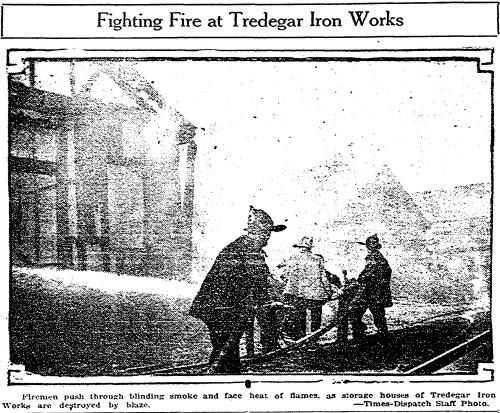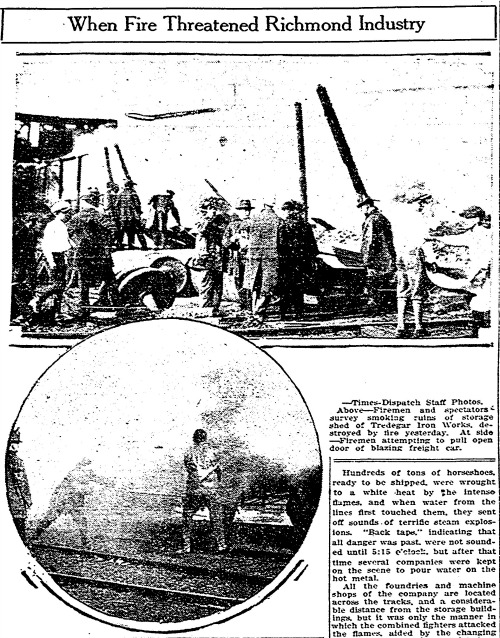From the Richmond Times-Dispatch, 4/25/1926, p. 1, c. 4

SPECTACULAR FIRE DAMAGES THE OLD TREDEGAR PLANT
Historic Iron Works Suffer Extensively in Stubborn Blaze.
SIX BUILDINGS BURN; PLACE LOSS AT $40,000
One Fireman Collapses From Heat and Stifling Smoke.
Damage estimated at $40,000 was suffered by the Tredegar Iron Works, Sixth Street and Canal bank, but a spectacular three-alarm fire shortly after 3 o’clock yesterday afternoon. Six storage buildings containing finished horseshoes were completely destroyed, a small locomotive, several freight cars and the locomotive house wrecked, and one machine house slightly damaged.
Twenty horses, quartered in a stable a short distance from the fire zone, were sent to safety by Sergeant Sam Flournoy, as the roof of the stable caught on fire from the terrific heat, but the stable was later saved.
So intense was the heat and stifling smoke from the blazing mass, one fireman was injured about the body, when he collapsed from the severe hardship, and another was later overcome by smoke. L. V. Cooley, of Truck Company No. 1, was severely bruised about the body, when he fell down an embankment, after being overcome. He was taken to headquarters and treated by the fireman’s physician, and then taken to his home. “Buck” Tyler, Engine Company No. 3, was overcome by smoke, after the fireman had penetrated one of the blazing buildings, but returned to duty as soon as he was revived.
High Wind Fans Flames.
A high wind fanned the flames into a roaring inferno, and for a considerable time after the arrival of the firemen it was believed that the entire section would be devoured. Eight engine companies and two truck companies responded to the alarms, under command of Assistant Chief Jones and Battalion Chiefs Wise and Taylor. The location of the fire, and the tremendous headway the flames had made, made it difficult for the firemen to get hose lines into action.
The Tredegar Iron Works is the oldest and most historic iron foundry in America. It was founded in 1826, and the armor plate for the Confederate ironclad, Virginia, was made in the plant. During the War Between the States ammunition was made there for the Confederate Army, and during every war since ammunition has been made for the government.
In 1878 the foundry failed, but was reorganized shortly afterwards, and since that time has operated successfully. The plant covers several acres, on the banks of the James River, and thousands of tons of finished products are stored there at all times.
It was in the extreme upper end of the yard that the fire was discovered yesterday afternoon. The first alarm was sounded from box 37, Church and Rowe Streets, but as soon as the first contingent arrived, the second alarm was sounded from box 84, the private alarm of the foundry.
The fire was said to have been first discovered in the shed that housed one of the timy switch engines before the alarm could be sounded, it had spread in all directions, fanned by the high wind. The stable, from which the horses were liberated, was located on the top of a hill, a hundred yards from that point, but the buildings that were located below the engine shed, across the railroad tracks from the stable.
Huge piles of iron mouldings of all descriptions added to the difficulty encountered by the firemen. A constant and blinding pall of smoke and swishing currents of intense heat drove the firemen back time after time from the blazing buildings. Spectators, huddled about over every inch of the hillsides and even on the high fence surrounding the plant, were also driven back several times by the smoke and heat.
Smoke from the burning buildings covered the south and western parts of the city, and attracted several thousand spectators, even after the flames were under control.
Fire officials said that the fire was the most spectacular and stubborn blaze fought here for several years, and it was only after the firemen had braved every hazard that the fire was brought under control.
Hundreds of tons of horseshoes, ready to be shipped, were wrought to a white heat by the intense flames, and when water from the lines first touched them, they sent off sounds of terrific steam explosions. “Back taps,” indicating that all danger was past, were not sounded until 5:15 o’clock, but after that time several companies were kept on the scene to pour water on the hot metal.
All the foundries and machine shops of the company are located across the tracks, and a considerable distance from the storage buildings, but it was only the manner in which the combined fighters attacked the flames, aided by the changing wind, that prevented a complete loss.
The finished product was damaged considerably, and will have to be remolded, fire officials said, but it could not be estimated what that loss will be. The estimate included only buildings and railroad equipment, which was totally destroyed.
During the fire a huge freight locomotive, ready to open its fire hydrant, patrolled the long railway trestle close to the iron works, in case the railroad trestle should catch fire from the intense heat.

- Details
- Categories:: Richmond Times-Dispatch Post-War Newspapers After 1865 Tredegar Iron Works Fires
- Published: 15 October 2017

